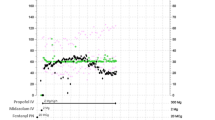Abstract
Bone cement implantation syndrome (BCIS) is characterised by hypotension, hypoxaemia, cardiac arrhythmias, cardiac arrest or any combination of these, leading to death in 0.6–1% of patients. One of the mechanisms suggested to explain these complications is diffuse microembolisation of the lungs as a consequence of extrusion of the bone marrow content by the pressurised bone cement. By reducing intramedullary pressure and changing the operative technique, BCIS can be diminished, but deaths still occur. An anaphylactoid mechanism as a major factor in BCIS is receiving renewed attention since increased plasma histamine levels were recently demonstrated after the implantation of bone cement and a prosthesis. Therefore, we conducted a prospective, randomised study to demonstrate the potential benefit of histamine-receptor-blocking agents in patients undergoing cemented hip arthroplasty. Thirty patients were divided into two groups: group 1, the control group, received no histamine-receptor-blocking agents; group 2, the antihistamine group, received H1 and H2-receptor-blocking agents in standard dosages preoperatively. Both groups were comparable concerning age, sex and physical status (ASA criteria). There was no hospital mortality in either group. Thirteen patients of group 1 demonstrated a sudden fall by more than 10% of their blood pressure, level of PaO2 or both. Fourteen patients of group 2 showed similar changes. The mean decrease of blood pressure in group 1 was 14.6 mmHg (SD 36.8) and in group 2 20.5 mmHg (SD 33.43). The difference is not significant (P = 0.65). The mean decrease of PaO2 in group 1 was 30.5 mmHg (SD 30.5) and in group 2 33.4 mmHg (SD 34.1). The difference is not significant (P = 0.81). Overall, we found even a slight disadvantage for patients receiving antihistamine drugs (statistically not significant). Therefore, histamine-receptor-blocking agents do not have a prophylactic potential in BCIS.
Similar content being viewed by others
References
Charnley J (1960) Anchorage of the femoral head prosthesis to the shaft of the femur. J Bone Joint Surg [Br] 42:28
Duncan JA (1989) Intraoperative collapse or death related to the use of acrylic cement in hip surgery. Anaesthesia 44:149–153
Eggert A, Huland H, Runke J, Seidel H (1974) Der Übertritt von Methylmethacrylat-Monomer in die Blutbahn des Menschen nach Hüftgelenksersatzoperationen. Chirurg 45:236–242
Fairmann RP, Morrow C, Glauser FL (1984) Methylmethacrylate induces pulmonary hypertension and increases lung vascularity in sheep. Am Rev Respir Dis 130:92–95
Hallin G, Modig J, Nordgren L, Olerud S (1974) The intramedullary pressure during bone marrow trauma of total hip replacement surgery. Upsala J Med Sci 79:51–54
Heinrich H, Kremer P, Winter H, Wörsdorfer O, Ahnefeld FW (1985) Transoesophageale zweidimensionale Echokardiographie bei Hüftendoprothesen. Anaesthesist 34:118–123
Hemdon J, Bechtol C, Crickenberger D (1974) Fat embolism during total hip replacement — a prospective study. J Bone Joint Surg[Am] 56:1350–1362
Jensen JS, Trap B, Skydsgaard K (1991) Delayed contact hypersensitivity and surgical glove penetration with acrylic bone cements. Acta Orthop Scand 62:24–28
Kallos T, Enis J, Gollan F, Davis J (1974) Intramedullary pressure and pulmonary embolism of femoral medullary content in dogs during insertion of bone cement and prosthesis. J Bone Joint Surg 56:1363–1367
McLaughlin RE, DiFazio CA, Hakala M, Abbott B, MacPhail JA, Mack WP, Sweet DE (1973) Blood clearance and acute pulmonary toxicity of methylmethacrylate in dogs after simulated arthroplasty and intravenous injection. J Bone Joint Surg 55:1621–1628
Modig J, Busch C, Olerud S, Saldeen T, Waernbaum G (1975) Arterial hypotension and hypoxemia during total hip replacement: the importance of thromboplastic products, fat embolism and acrylic monomers. Acta Anaesthesiol Scand 19:28–43
Park WY, Balingit P, Kenmore PI, Macnamara TE (1973) Changes in arterial oxygen tension during total hip replacement. Anaesthesiology 39:642–644
Peebles DJ, Ellis RH, Stride SD, Simpson BR (1972) Cardiovascular effects of methylmethacrylate. Br Med J 1:349–351
Powell JN, McGrath PJ, Lahiri SK, Hill P (1970) Cardiac arrest associated with bone cement. Br Med J 3:326–327
Rinecker H (1980) New clinico-pathophysiological studies on the bone cement implantation syndrome. Arch Orthop Trauma Surg 97:263–274
Svartling N, Pfaffli P, Tarkkanen L (1986) Methylmethacrylate blood levels in patients with femoral neck fractures. Arch Orthop Trauma Surg 104:242–246
Tordjmann G, Helmer J, Kipper R, Delagoutte JP, Vivin P (1986) Dosage du methacrylate de methyle dans les gaz expires après scellement de prothèse de hanche. Ann Fr Anesth Réanim 5:110–114
Tryba M, Linde I, Voshage G, Zenez M (1991) Histamine release and cardiovascular reactions to bone cement used in total hip replacement surgery. Anaesthesist 40:25–32
Ulrich C, Burri C, Wörsdörfer O, Heinrich H (1986) Intraoperative transesophageal two-dimensional echocardiography in total hip replacement. Arch Orthop Trauma Surg 105:274–278
Wenda K, Ritter G, Ahlers J, von Issendorff WD (1990) Detection and effects of bone marrow intravasations in operations in the area of the femoral marrow cavity. Unfallchirug 93:56–61
Author information
Authors and Affiliations
Rights and permissions
About this article
Cite this article
Lamadé, W.R., Friedl, W., Schmid, B. et al. Bone cement implantation syndrome. Arch Orthop Trauma Surg 114, 335–339 (1995). https://doi.org/10.1007/BF00448957
Received:
Issue Date:
DOI: https://doi.org/10.1007/BF00448957




